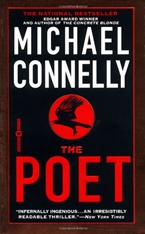Mon 30 Nov 2009
MICHAEL CONNELLY – The Poet. Little Brown, hardcover, January 1996. Trade paperback: Warner, July 2002; mass market paperback: Warner Vision, January 1997.

Jack McEvoy is a reporter for the Rocky Mountain News, and Death is his beat; he covers stories in which someone has died, be it by murder, suicide or accident. Now he is in the back seat of a police car on the way to his brother’s house to tell his sister-in-law that her husband is dead.
His brother Sean was a police detective who apparently drove to a nearby lake and shot himself. Over the past several weeks he had been investigating the murder of Theresa Lofton, a teenage girl whose body was discovered in a park, severed in half.
The case seemed to have gotten to him so badly that he killed himself, leaving as his only note a line of poetry on his car’s fogged up window: a line from a poem by Poe that’s contained in the story “The Fall of the House of Usher.”
After a vacation following his brother’s funeral, Jack decides to do a story on the rate of suicides by policemen. While researching it, he comes across an article in the New York Times that mentions the suicide of a Chicago detective who obsessed over the murder of a little boy — a case also unsolved. His suicide note also consisted of a line of poetry from Poe.
That’s too coincidental for Jack. He’s soon traveling to Washington, D. C. and Baltimore where his investigation comes to the notice of the FBI. The FBI reluctantly agrees to join forces with him (to keep him from writing about it prematurely) as they discover at least six cases of policemen who apparently committed suicide, leaving as their only notes a line from Poe.
Meanwhile, every third or fourth chapter is not told in the first person by Jack but is in the third person as we follow a pedophile named William Gladdin as he tries to stay in the business of taking shots of unclad children to peddle over the internet.
Extremely well written, with fine characterization and gripping suspense up to a point, but I felt Connelly may have gone overboard with the twists at the end. It seems to have done well enough, as there has been a sequel, The Narrows, a book in which Harry Bosch appears.
—
Editorial Comment: Ray recently reviewed The Narrows here on this blog. It’s my error in posting them in the wrong order!












